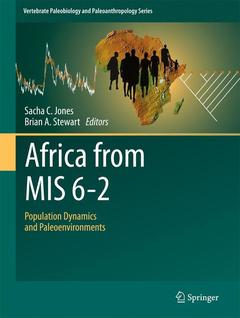Africa from MIS 6-2, 1st ed. 2016 Population Dynamics and Paleoenvironments Vertebrate Paleobiology and Paleoanthropology Series
Coordonnateurs : Jones Sacha C., Stewart Brian A.

Chapter 1 Africa from MIS 6-2: The Florescence of Modern Humans.- Part I Coasts.- Chapter 2 Mid to Late Quaternary Landscape and Environmental Dynamics in the Middle Stone Age of Southern South Africa.- 3 Chapter Technological Change and the Importance of Variability: the Western Cape of South Africa from MIS 5-2.- Chapter 4 Cultural Change, Demography, and the Archaeology of the Last 100 kyr in Southern Africa.- Chapter 5 Patterns of Hominin Occupation and Cultural Diversity Across the Gebel Akhdar of Northern Libya over the Last ~200 kyr.- Part II Deserts.- Chapter 6 Climate Change and Modern Human Occupation of the Sahara from MIS 6-2.- Chapter 7 Climate, Environment and Population Dynamics in Pleistocene Sahara.- Chapter 8 Technological Systems, Population Dynamics and Historical Process in the MSA of Northern Africa.- Chapter 9 Late Quaternary Environmental Change and Human Occupation of the Southern African Interior.- Chapter 10 The Kalahari During MIS 6-2 (190-12 ka): Archaeology, Paleoenvironment and Population Dynamics.- Chapter 11 Paleoenvironments, Sea Levels and Land Use in Namaqualand, South Africa, During MIS 6-2.- Part III Grasslands, Woodlands and Rainforests.- Chapter 12 Human Evolution in Late Quaternary Eastern Africa.- Chapter 13 Environmental Change, Ungulate Biogeography, and their Implications for Early Human Dispersals in Equatorial East Africa.- Chapter 14 Follow the Senqu: Maloti-Drakensberg Paleoenvironments and Implications for Early Human Dispersals into Mountain Systems.- Chapter 15 Across Rainforests and Woodlands: A Systematic Re-appraisal of the Lupemban Middle Stone Age in Central Africa.- Chapter 16 The Later Pleistocene in the Northeastern Central African Rainforest.- Part IV Broader Perspectives.- Chapter 17 The Late Quaternary Hominins of Africa: The Skeletal Evidence from MIS 6-2.- Chapter 18 A Genetic Perspective on African Prehistory.- Chapter 19 Africa From MIS 6-2: Where Do We Go From Here?.
Date de parution : 03-2016
Ouvrage de 424 p.
21x27.9 cm



